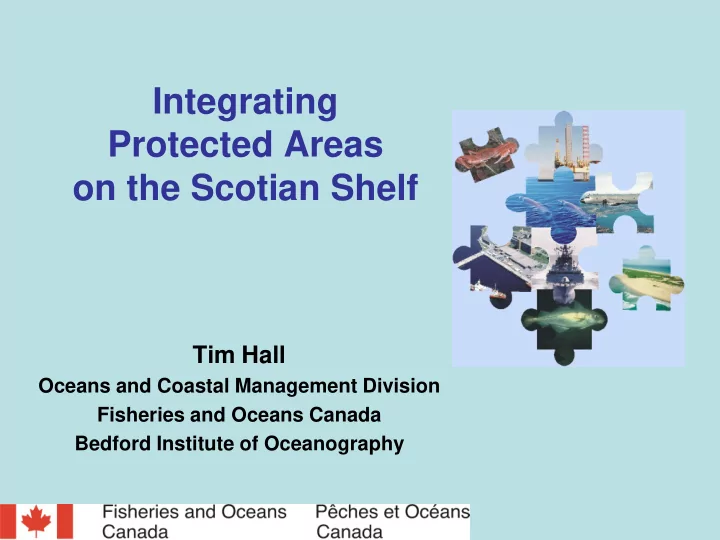

Integrating Protected Areas on the Scotian Shelf Tim Hall Oceans and Coastal Management Division Fisheries and Oceans Canada Bedford Institute of Oceanography
Nfld Grand QUEBEC ONTARIO Banks NB Georges The Gully Bank
Halifax The Gully 0 200 km The Gully MPA Largest submarine canyon in eastern North America
Northern bottlenose whale ( Hyperoodon ampullatus ) 34% of 140 individuals found in the Gully at any one time Assessment Status: Endangered (2002) Photo: J.F. Gosselin
Corals in the Gully - Campod surveys (1998-2002) Primnoa - 14 + species Anthomastus Paragorgia Acanthogorgia Capnella Keratoisis Flabellum
Boundary & Zones Area : 2360 km 2 Zone 1 : Highly restricted deep-water core >600m (few activities permitted) Zone 2 : Protection for trough, canyon sides and outer area (some fisheries allowed) Zone 3 : Shallow-water sandy banks <300m (compatible uses subject to stringent review)
Managing Fisheries • Excepted hook & line fisheries access Zones 2 and 3 under Fisheries Act license conditions • All other fisheries excluded from MPA • Gully MPA section being added to relevant Integrated Fishery Management Plans • Monitoring and reporting procedures apply – observers, logbooks, dockside monitors – surveillance (Fisheries, Navy, Coast Guard etc.)
Compliance Monitoring System • Compiles multiple and remote data sources – vessel monitoring system (hourly by satellite) – aerial sightings (daily in some seasons) – radio calls to hail in-out of port – vessel and observer logbooks • Automatic detection of – unauthorized fishing – misreporting of positions and catch composition – loitering and data anomalies
Research Activities • Research and monitoring are encouraged – emphasis on MPA understanding & evaluation • Domestic – must submit plans for approval – reviewed by MPA Advisory Committee – approved by Minister of Fisheries and Oceans • Foreign – consent under Coasting Trade Act – Applications now routed to MPA managers – proponents must comply with MPA regulation
Managing Beyond the Boundary 0 200 km Eastern Scotian Shelf Integrated Management Area
Oil & Gas Exploration • Prohibited in MPA by policy • Adjacency protocols being developed – expanded environmental assessment – mitigation, monitoring and observer requirements • National seismic guidelines apply • Voluntary codes of conduct by industry – no vessel transit or aircraft in the MPA • Collaborative research and effects monitoring
Hydrocarbon licences (2004) and seismic acquisition lines (1998-2003)
Marine Transportation • Navigation rights excepted – must comply with Canadian Shipping Act & – International Maritime Organization requirements • Chart updates – boundary added to paper and digital products • Coast Guard Notice to Mariners – Guidelines: avoidance, mammals, discharges • Ballast water exchange zones – New regulations accommodate the Gully
50 km Advisory Ballast Water Exchange Zone Incoming Ship Traffic
The Eastern Scotian Shelf Integrated Management (ESSIM) Initiative • First integrated ocean management initiative with an offshore focus under the Oceans Act • Addressing multiple ocean uses and jurisdictions, increasing space competition, and need for an ecosystem approach • A collaborative process to develop and implement an integrated ocean management plan
• Map of conservation areas/corals here?
Legislative & Policy Context • Oceans Act provides legal basis (DFO lead agency) • Canada’s Oceans Strategy affirms integrated management as a priority • National Integrated Management Policy and Operational Framework provides guidance • Oceans Action Plan (2004-06) & Health of the Oceans Program (2007-12) support implementation • Reflects our international commitments
The ESSIM Plan • Strategic level, objectives-based plan for sustainability on the Eastern Scotian Shelf • Building on, improving and coordinating existing management jurisdictions and responsibilities • Linking sector-based planning and decision making to an overarching set of objectives, strategies, actions and outcomes …a shared commitment to work together for our ocean and our future…
Goals of the plan Collaborative governance and integrated management Capacity among stakeholders. Knowledge to support integrated management. Effective governance structures and processes. Sustainable human use Healthy ecosystems Resilient and productive Ecologically sustainable use of ecosystems, with diverse habitats, ocean space and resources. communities, species and populations. Sustainable communities and Strong marine environmental economic well-being. quality supports ecosystem functioning.
Spatial conservation action plan • Share knowledge among stakeholders about the concept and practice of spatial conservation planning, areas that are currently managed for conservation purposes, and areas that have been identified as having conservation value. • Assess the contribution of existing management areas and identify gaps in conservation efforts. • Identify and build agreement on areas of conservation priority and make recommendations for action. • Steward the implementation of recommendations (including interim protection options).
Multiple use planning
GIS decision support (“GISMO”)
MPA network planning 37 33 34 30 32 40 29 35 36 42 27 15 25 28 26 23 24 37 14 13 8 17 39 10 33 12 1 9 34 11 + 6 30 31 32 40 35 36 29 42 5 27 25 15 2 28 26 23 24 14 13 8 17 39 10 12 1 9 11 6 31 + 5 2 = 1 “ecological” + network (initially 6- 10 candidate sites) and 1-2 new Oceans Act “Areas of Interest” this year
Some Lessons for Integration • Collaborate and integrate whenever possible – use vessels and aircraft of opportunity – employ other laws and management frameworks – learn by doing; build protocols with experience • Get the word out widely, listen and respond – Target educational materials and outreach through customary sector networks – Provide interpretation and at-sea direction for user groups. (“What does it mean for me?”) • Employ non-regulatory & voluntary measures – Operator guidelines (e.g., avoidance) – Interagency arrangements and agreements – Industry stewardship & codes of practice
Recommend
More recommend